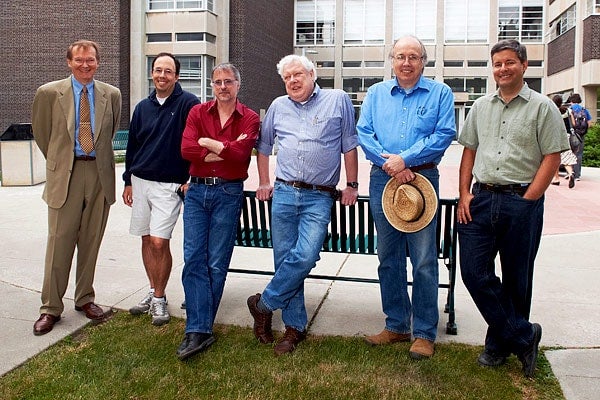
World science community abuzz as Higgs boson results announced
Published: July 4, 2012
The international team of researchers that has been smashing high-energy protons together inside the Large Hadron Collider (LHC) to recreate the conditions at the time of the Big Bang has announced new evidence which may be the long awaited observation of the Higgs boson.
“The results are an incontrovertible demonstration of the existence of a hitherto unobserved particle," said Robert Orr, founder of the U of T team searching for the Higgs. "This alone is an exciting observation. The mass and other attributes of this particle are consistent with what is expected for the Standard Model Higgs boson.”
The Higgs boson is a hypothetical massive elementary particle that is predicted to exist by the Standard Model of particle physics. The Standard Model has been the basis of particle physics for more than 30 years and describes the forces between particles of matter. The Higgs boson is the missing ingredient in the model that has been hypothesized to explain the existence of the masses of the most elementary particles making up the universe.
At a joint seminar held in Geneva on July 4, scientists from the LHC's two main experiments, ATLAS and CMS, met to report results of the search for the Higgs boson from data collected over the last two years. Neither team knew the other's results in advance.
“Definite identification of this newly observed particle as the Standard Model Higgs boson will require further extensive study,” said Orr. The results presented today show an excess of events corresponding to a particle with a mass of 126.5 GeV. (1 GeV is the mass of a proton, so the Higgs is about 126 times heavier than a proton.)
“This observation certainly looks like the Higgs boson," said Orr. "As an experimenter, one can take the attitude that we have observed a new phenomenon in nature; a particle that no one has observed before. While the most obvious interpretation is the Standard Model Higgs boson, we need to do further work to be sure of that. It could also be the precursor of new and unexpected phenomena.”
“Remember, the usual story is that Columbus set out to sail to India. He did find land as he hoped for, but it wasn’t India; it was something much more exciting. We may have arrived at India; or it could be the New World. In any case, this observation is just the beginning of our work."
The U of T high-energy physicists, along with their 2,500 ATLAS colleagues from 35 countries, have played a key role in the hunt for the Higgs. The ATLAS detector, key components of which were built at U of T, was designed to search for new particles in the highest mass collisions of high-energy proton collisions in the LHC. The group of 30 U of T researchers, including 16 graduate students, has used the SciNet super-computing resources at U of T to sift through the ATLAS data to identify collisions containing Higgs boson candidates.
"This is a historic moment for particle physics and we all feel privileged to be part it. It has taken 20 years to design and build this experiment and today, we can say that one of its main goals has been achieved," said U of T's Pierre Savard, the Canadian ATLAS physics coordinator and a member of the scientific staff at TRIUMF, Canada's National Laboratory for Particle and Nuclear Physics.
The LHC, the world's largest and highest-energy particle accelerator, was launched on March 27, 2010. Located in Geneva, the collider has a circumference of 27 kilometres and is 100 metres underground.
The U of T faculty members involved in the project are David Bailey, Peter Krieger, Robert Orr, Pierre Savard, Pekka Sinervo, William Trischuk and Richard Teuscher.
You can read background information on the Higgs boson prepared by Pekka Sinervo here.


